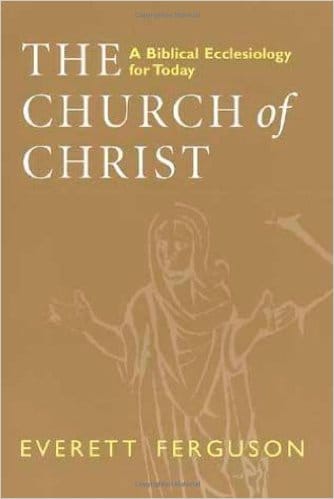One of my primary goals on this blog is to help us think biblically about church. As I seek to grow in my own understanding, I find it helpful to read authors who wrestle directly with Scripture, form conclusions, and send me back to Scripture myself to weigh their conclusions.
Recently I’ve finally begun one such book, one that has been calling my name for several years: The Church of Christ: A Biblical Ecclesiology for Today, by Everett Ferguson.
Ferguson is best known as an historian of the early church, having written books such as the seminary standard Backgrounds of Early Christianity and, more recently, a massive book on Baptism in the Early Church. I recommend both.
But in this book Ferguson aims to speak as a biblical student, not as an historian. Here is how he explains things in his Preface:
Recent scholarship has emphasized the diversity of theologies within the New Testament… I have chosen to pay more attention in this study to the melody than to the individual instruments.
Although the synthetic approach adopted in this book may be out of fashion, the recognition of the authority of a canon of scripture… justifies the effort to bring together the teaching of the various New Testament documents… This kind of reading does not serve the purposes of historians well, but it is a necessary task for theologians.
The book is written by one whose academic training is primarily that of a historian, but a historian interested in theology who has used history as a way of understanding theological questions. I have set my hand in this work to a book that is completely theological and systematic…
The “Today” in the subtitle does not mean a tailoring of biblical ecclesiology to the interests of the present but is meant to emphasize that biblical ecclesiology is viable today… (pp. xiv-xv)
So far I am only about 136 pages into Ferguson’s 443-page book. But I’m starting to like it enough that I’ve decided I’d like to share a series of posts quoting and interacting with this book.
Ferguson arranges his book in a way that is unexpected but exactly right: around Jesus. After the Preface and Introduction, the book consists of six long chapters, each building on some aspect of Jesus’ identity and work:
- The People and the Messiah: History and Eschatology
- The Church and Her Lord: The Nature of the Church
- The Church and Her Savior: Salvation and Church Membership
- The Church and Her High Priest: Worship and Assembly
- The Church and Her Bishop: The Continuing Ministry
- The Church and Her Teacher: The New Way of Life
Don’t let these titles overwhelm you. They repay close reading. For example, note that Jesus is identified by six titles: Messiah, Lord, Savior, High Priest, Bishop, and Teacher. Ferguson uses these titles of Jesus to understand the church. Thus (in chapter three), if Jesus is “Savior,” how should this shape our understanding of church membership? Or (in chapter five), if Jesus is “Bishop,” how should this shape our understanding of human leaders and servants within the church?
This means that all the “practical” topics you may be curious about are probably found in one of those chapters. For example, subheadings address things such as this:
- The Body of Christ
- The Family of God
- The Meaning of Ekklesia
- Attitudes toward Worship
- Activities in the Assembly
- Shepherds, Preachers, and Servants
- Discipline
- Unity
I’m thinking I’ll share about seven posts on this book—this one plus one for each chapter. If I am bursting with extra thoughts and time, one more concluding post may appear.
To wrap up this first post, here are some highlights I enjoyed from the book’s Introduction:
God gave a person, then a proclamation, and then a people. This is the historical and theological order.
God gave first a person, Jesus Christ…
The proclamation centers in the person…
The proclaimed word calls and gathers a people… This book studies the people, the church. As such it is concerned with what is derivative and in third position… I seek to relate every aspect of the doctrine about the church to Christ…
The oral message about Jesus Christ gathered a people and so created a church. That word was put in written form… In a historical sense, one may say that “the church gave us the Bible.”… Although the church was historically prior to the Bible as a given collection of books, the word contained in the Bible was theologically prior to the church. The recognition of a canon of scripture was an acknowledgment by the church that it was not its own authority and was an act of submission to the authority of apostolic preaching inscripturated in the apostolic writings…
The witness of the first generations of Christians about what was authoritative for them is an irreversible decision and remains determinative of what the essence of Christianity is… The historical circumstances of the first century are not normative for Christians in later centuries, but the apostolic teaching given in those historical circumstances is normative…
The effort to find an authoritative word in scriptures on the matters discussed does not mean adopting the kind of “proof-text” approach that often takes verses out of context. The effort has been made to show the interconnectedness of themes…
There is such an interconnectedness of themes that this book could almost be considered a New Testament theology organized with reference to ecclesiology. It is not that; there are too many aspects of New Testament theology that are not included…
The person of Jesus is more attractive than those who claim to follow him are. But… one cannot have Jesus without the church. We hope to show that Christ or the church is a false alternative… To emphasize Christ is to make his church important.
Sometimes people, finding the heart of the gospel, want to treat the rest of biblical teaching as irrelevant. It may be secondary, but it is not irrelevant. The proper procedure is to work out from the center of the gospel to other things and apply the gospel to other aspects of doctrine. On our topic, that means working from Christ to the nature of the church and its activities…
Perhaps the problem for many has been in taking the church too much in an institutional sense and not sufficiently in terms of a people, a redeemed community… The church may often have been presented in such a way as to obscure Christ…
The first three chapters of this book develop the theological axiom that Christology and soteriology determine ecclesiology. The last three chapters then apply this insight to the ministry, worship, and life of the church. We want to take seriously that this study concerns the church of Christ. He gives existence, meaning, and purpose to the church. Christology is the norm for ecclesiology, and that is what justifies the title of the book. (pp. xvii-xx, bold added)
I won’t add much to that except to say that typing those excerpts renews my excitement about Ferguson’s focus as he examines ecclesiology. Whatever points of disagreement we may discover with him along the way, he has certainly started his study very well indeed!
What stands out to you from these introductory thoughts from Ferguson? What do you want to say Amen to? Is there anything you’d balance differently? What do you hope he addresses (and I review) in his book? Share your insights below.
Note: I participate in an Amazon affiliates program, so if you buy a book using the links above, I will earn pennies. Thanks!



